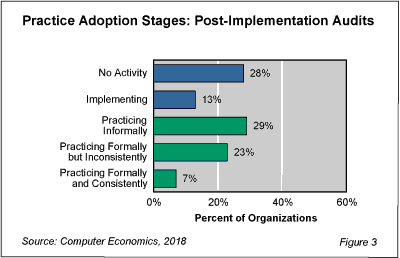Implementing a new system can be a risky endeavor, and once implementation is complete it is tempting to spike the football and move on to the next project. But implementation is just the start of another phase in the system development life cycle: the post-implementation stage. Go-live is not just the end of the implementation project but the beginning of ongoing use and support for the new system.
As shown in Figure 3 from the full report, Post-Implementation Audits Adoption and Best Practices, most IT organizations fail to conduct these audits, or they fail to do them formally and consistently. In fact, post-implementation audits are one of the least mature of the 32 best practices that we study, with a mere 7% of respondents conducting such audits formally and consistently.

At a point following the go-live, a post-implementation audit should be conducted to evaluate how the system is actually being used, determine what benefits have been achieved, what lessons can be learned, and what corrective actions should be taken to ensure maximum success with the new system. Post-implementation audits provide an important feedback loop for the organization to learn from its experience and continually improve its performance in IT project delivery. They also can help the IT organization establish its value to the business.
“Post-implementation audits are a longstanding best practice, but too many organizations blow them off,” said Tom Dunlap, director of research for Computer Economics, based in Irvine, Calif. “Our research shows that most IT leaders underestimate them. That’s a mistake, because future projects can be delivered more effectively if you learn lessons from past projects, not to mention that new systems in trouble may still be able to be saved from failure by timely intervention.”
One factor that may be restraining the adoption of post-implementation audits is an attitude that sometimes comes from advocates of agile development. Some agile proponents view nearly anything other than coding as a non-value-add. Since post-implementation audits do not add functionality to the system, they may lump them in with documentation and project status reports as a form of waste. However, post-implementation audits are not contrary to agile development. Even under agile development, at some point the system reaches a stable release and goes into periodic enhancements. At that point, a post-implementation audit is appropriate and provides a global perspective that compares the implemented system with its original objectives, especially in terms of its actual user experience and benefits achieved.
In the full report, we look at adoption trends for post-implementation audits by organization size and sector. We also discuss best practices in conducting post-implementation audits.
This Research Byte is a brief overview of our report on this subject, Post-Implementation Audits Adoption and Best Practices. The full report is available at no charge for Computer Economics clients, or it may be purchased by non-clients directly from our website (click for pricing).

